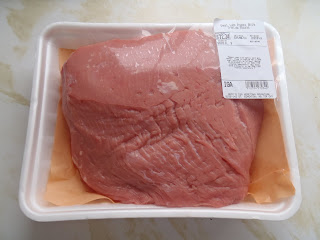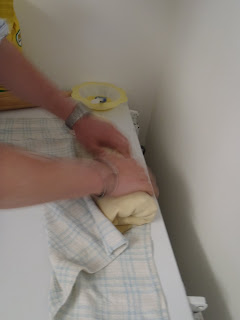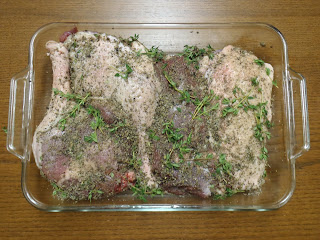When cooking, eating, and drinking outside the industrial system, food legislation often conflicts with food culture and individuals' rights. Here are some examples.
Alberta Public Health Food Regulations
The provincial public health food regulations apply to operations such as restaurants, food stands, farmers' markets, bake sales and the like. While I consider the restaurant scene only a peripheral component of our food culture, some of the restrictions put on restaurants clearly reflect how we think of food. In fact, several of the most pleasurable ingredients and preparations are misunderstood and considered too dangerous to allow.
In our food regulations, temperature is the only wholly acceptable way to control bacterial growth. Temperatures below 4°C inhibit bacterial growth, while temperatures above 60°C kill most bacteria. Perishable food can be in the "danger zone" between these two temperatures for no longer than two hours before it is considered unsafe and unfit to serve.
In the food safety courses of Alberta Health Services, there is mention of the other ways to curb bacterial growth (such as controlling acidity, moisture, and sugar content), but none supersede the two hour danger zone rule. Restaurants can't, for example, dry cure salami or saucisson sec by the traditional methods. For these sausages, ground meat is mixed with curing salt and a bacterial culture that produces acid, which inhibits the growth of pathogens. This is what gives salami its characteristic tang. Next the meat is hung in cellar conditions (between 8°C and 15°C) for a few weeks to dry. The removal of moisture further prevents the growth of pathogens. Even though bacterial growth is precisely controlled by salting, pH adjustments, and thorough drying, a health inspector would see that the meat is being held in the "danger zone" and document a critical violation of food safety.
Some of the greatest "low and slow" cooking methods, like confit and smoking, hold meat in the danger zone for more than the allotted two hours.
The health inspector's mantra is, "Hot food hot, cold food cold," meaning that food should be held and served with an internal temperature either above 60°C, or below 4°C. Serving food at these temperatures can be disagreeable, especially cold dishes. Several high-fat foods should be eaten at room temperature. Examples include pâtés, rillettes, the bacon on caesar salads, and cheese. The fat has to be at room temperature for two reasons. First is appearance: you want the bacon on your caesar salad to shine, not have globules of congealed white fat. Second is flavour and mouthfeel: the warm fat coats your tongue and helps distribute the bacon flavour. High quality cheeses should be taken out of the fridge hours before being served. I would make the same argument for hard-boiled eggs.
Which reminds me, raw eggs in all forms are discouraged: mayonnaise, and, incredibly, meringue. Even when meringue is baked, the mixture doesn't get hot enough to pasteurize the egg whites, and is therefore not safe to eat.
I agree that controlling temperature is the most effective way of controlling bacterial growth. I also admit that most of the restaurants in Edmonton have no desire to cure their own meat or smoke ribs for ten hours. Restrictive food regulations obviously don't cripple the restaurant scene. I just think they reflect our general lack of food knowledge and appreciation.
Unpasteurized Milk
This is probably the most publicized conflict between public health and individual rights: both provincial and federal legislation prohibit the distribution of unpasteurized milk. There is, however, a now-famous Ontario dairyman who sells shares in his cows, enabling him to legally distribute raw milk to the many "owners".
To me the most interesting discussion surrounds raw-milk cheese, as pasteurization kills naturally occurring bacteria and enzymes that help develop the flavour of ripened cheese.
It is legal to sell cheese made from unpasteurized milk, so long as the cheese has been aged for more than sixty days, as the salt and acid in the cheese make it impossible for pathogens to survive this period of time. The problem is that soft, ripened cheeses such as Brie and Camembert reach their peak flavour and texture after only thirty days of aging.
The sixty day minimum aging applies to all provinces except Quebec, which in 2008 passed a law allowing the sale of raw-milk cheese aged less than sixty days. My understanding is that this cheese could not be sold in Alberta, as food moving between provinces is regulated by the Food and Drugs Act, which upholds the sixty day aging minimum for raw-milk cheese.
The last time raw-milk cheese was in the Alberta news was in early 2003, when an E. coli outbreak was traced back to a cheesemaker in Leduc called Eyot Creek. There was a flurry of articles on the outbreak, and distribution was stopped immediately. The results of Capital Health's investigation were never thoroughly discussed in the media. To my knowledge, Eyot Creek didn't violate any regulations, and their cheese, while made from unpasteurized milk, was aged for at least sixty days. It seems to me that the E. coli would have been introduced after the aging process, and therefore didn't originate in the raw milk. This wasn't addressed in any article or press-release that I have come across. The media coverage enforced the public's mistrust of raw-milk cheese.
To quote Harold McGee: "It will be genuine progress when public health officials help ambitious cheesemakers to ensure the safety of raw-milk cheeses, rather than making rules that restrict consumer choice without significantly reducing risk."[1]
Game Meats
Selling game meat, or "trafficking in wildlife", is prohibited by the Alberta Wildlife Act Regulations.
Larousse's entry on Canada gives an idea of how important game could be in our cuisine. "Four-fifths of the country consist of stretches of water and forests, rich in ground game ... and game birds... However, the state forbids the sale of these delicious foods which are reserved for private consumption." This includes restaurants. If you have ever had venison, boar, pheasant, rabbit, or any other "game animal" in a restaurant in Canada, is has been farmed and slaughtered in an abattoir.
Game meat is flavourful because of the variety of plants on which the animal feeds. Farmed animals never have access to the same quality or variety of feed as wild animals. In farming, the robust, complex flavour of the animal is lost, and the meat becomes a simple novelty.
I don't mean to malign the many hunting regulations that ensure future generations of Canadians will be able to hunt and taste game meat: it's just strange that someone who lawfully kills wildlife can't sell me the meat.
Home-Distilling
Most food-related regulations only restrict the sale of potentially harmful goods. For instance, it's not illegal to drink raw milk, or to make unripened raw-milk cheese, it's only illegal to sell it.
The Alberta Gaming and Liquor Act, however, prohibits any manufacture of liquor without a license, even if in small quantities for private consumption. To obtain the Class E Liquor License required to distill alcohol you must be running a commercial operation that produces hundreds of thousands of litres of alcohol a year.
The dangers of home-distilling are completely exaggerated and misunderstood. Most ridiculous is the idea that the stills often explode. This myth is a vestige of the days when open flames were used to boil the mash and evaporate the alcohol. If home-distilling were practiced regularly in modern homes, I'm sure electric burners would be used. (Maybe don't smoke while you distill.) To convince you that ordinary people can practice alcohol distillation safely, we recently partook in homemade schnapps from Austria, to no ill effect (besides, obviously, the intended intoxication.)
Given our historic association with grain-growing, prairie home-distilling would be a boon for our food culture.
On a completely unrelated note, 83% of the price of liquor goes towards federal and provincial taxes.[2]
Abattoirs
I have come across a few articles saying that provincial meat inspection regulations can be prohibitively expensive and sometimes result in the closure of small slaughterhouses. This is especially a concern for producers in isolated regions, such as coastal British Columbia, and producers of niche animals, like sheep, because there are fewer abattoirs they can use. The closure of local abattoirs means that these producers have to travel farther, sometimes much farther, to kill their animals. Travelling not only adds to the cost of the product, but stresses the animals and reduces the quality of their meat.
I recently spoke to an Albertan pork producer who was interested in selling blood sausage, but who couldn't procure his pigs' blood fresh enough, due to travelling time between his farm and the abattoir.
I have come across a few articles saying that provincial meat inspection regulations can be prohibitively expensive and sometimes result in the closure of small slaughterhouses. This is especially a concern for producers in isolated regions, such as coastal British Columbia, and producers of niche animals, like sheep, because there are fewer abattoirs they can use. The closure of local abattoirs means that these producers have to travel farther, sometimes much farther, to kill their animals. Travelling not only adds to the cost of the product, but stresses the animals and reduces the quality of their meat.
I recently spoke to an Albertan pork producer who was interested in selling blood sausage, but who couldn't procure his pigs' blood fresh enough, due to travelling time between his farm and the abattoir.
Conclusion: Underground Food Culture
The good news is that, with the exception of distillation, none of the above regulations dictate what you can do in the privacy of your own home. You can dry-cure meat, even though is stays in the danger zone for weeks. You can eat raw eggs and wild game and even ripen raw-milk cheese to perfection. In a weird way, if you take a few tentative steps outside of the industrial food system, the above legislation will force you into very close contact with your food. For instance, since I can't buy wild venison from a butcher shop, I need to learn to hunt, or at least befriend a hunter. Either way, I am being brought closer to my food than I would at a butcher shop.
That's my lame attempt at a silver lining.
References
1. McGee, Harold. On Food and Cooking. ©2004 Scribner, New York. Page 56.
2. Kendall, Kay and Bokji, Sandi (Ed.). Distilling Industry from The Canadian Encyclopedia. ©2010 Historica-Dominion. Site accessed on Monday, July 19, 2010.
Also, all the above-mentioned legislation is available online.
That's my lame attempt at a silver lining.
References
1. McGee, Harold. On Food and Cooking. ©2004 Scribner, New York. Page 56.
2. Kendall, Kay and Bokji, Sandi (Ed.). Distilling Industry from The Canadian Encyclopedia. ©2010 Historica-Dominion. Site accessed on Monday, July 19, 2010.
Also, all the above-mentioned legislation is available online.





























